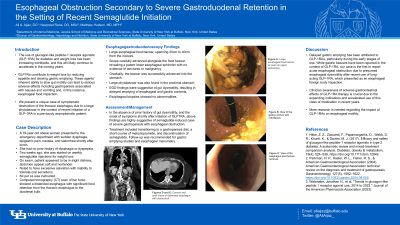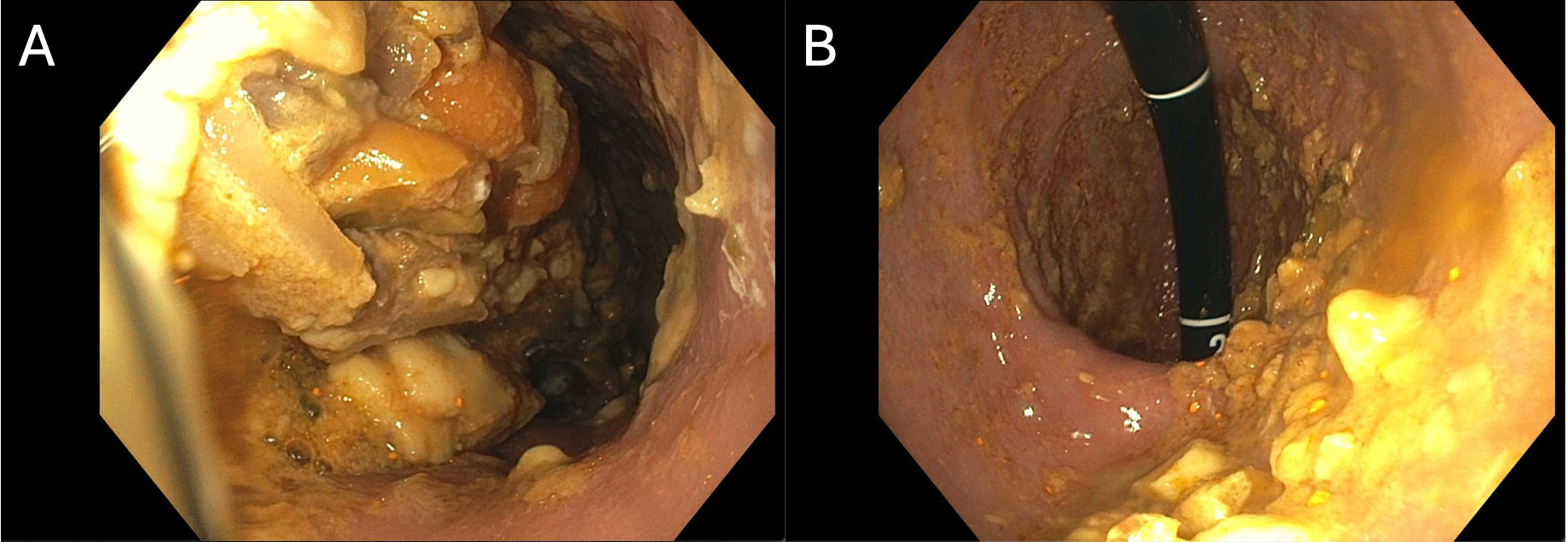Tuesday Poster Session
Category: Obesity
P4895 - Esophageal Obstruction Secondary to Severe Gastroduodenal Retention in the Setting of Recent Semaglutide Initiation
Tuesday, October 29, 2024
10:30 AM - 4:00 PM ET
Location: Exhibit Hall E

Has Audio
- AA
Ali A. Aijaz, DO
University at Buffalo
Buffalo, NY
Presenting Author(s)
Ali A. Aijaz, DO1, Navpreet Rana, DO1, Matthew J. Hudson, MD2
1University at Buffalo, Buffalo, NY; 2University of Buffalo Jacobs School of Medicine, Buffalo, NY
Introduction: The use of glucagon-like peptide-1 receptor agonists (GLP-1RA) for diabetes and weight loss has been increasing worldwide, and this will likely continue to accelerate in the coming years. Nausea and vomiting are known adverse effects of GLP-1RAs and previous studies showed that their use delays gastric emptying with associated gastric residue. We present a unique case of symptomatic obstruction of the thoracic esophagus due to a large phytobezoar in the context of recent initiation of a GLP-1RA in a previously asymptomatic patient.
Case Description/Methods: A 79-year-old obese woman presented to the emergency department with sudden dysphagia, epigastric pain, nausea, and sialorrhea shortly after lunch, suggestive of esophageal food impaction. She had no prior history of dysphagia or dyspepsia. She had started weekly semaglutide injections for weight loss two weeks earlier. Examination revealed intolerance to oral secretions. Computed tomography (CT) scan of her torso showed a distended esophagus with significant food retention from the thoracic esophagus to the duodenal bulb.
Upper endoscopy was performed and revealed a large esophageal food bezoar spanning from 20cm to 40cm from the incisors, with a patent esophagus and lower esophageal sphincter. No other abnormalities were found. The bezoar was gradually moved from the esophagus into the stomach with the endoscope in multiple small increments. A large phytobezoar was also found in the gastric fundus and body. Physiologically, delayed gastric emptying and phytobezoar formation due to recent semaglutide use was the suspected cause of esophageal retention presenting as acute esophageal obstruction.
Treatment included transitioning to a gastroparesis diet, a short course of metoclopramide, and discontinuation of semaglutide. Follow-up was recommended for gastric emptying studies and esophageal manometry. Esophageal biopsies showed no abnormalities.
Discussion: Delayed gastric emptying has been attributed to GLP-1RAs, particularly during the early stages of use. While gastric bezoars have been reported in the context of GLP-1RA, our case is the first to report acute esophageal obstruction due to presumed esophageal dysmotility after recent use of long-acting GLP-1RA, which presented as an esophageal foreign body impaction. Clinician awareness of adverse gastrointestinal effects of GLP-1RA therapy is crucial due to the expanding indications and accelerated use of this class of medication in recent years.

Disclosures:
Ali A. Aijaz, DO1, Navpreet Rana, DO1, Matthew J. Hudson, MD2. P4895 - Esophageal Obstruction Secondary to Severe Gastroduodenal Retention in the Setting of Recent Semaglutide Initiation, ACG 2024 Annual Scientific Meeting Abstracts. Philadelphia, PA: American College of Gastroenterology.
1University at Buffalo, Buffalo, NY; 2University of Buffalo Jacobs School of Medicine, Buffalo, NY
Introduction: The use of glucagon-like peptide-1 receptor agonists (GLP-1RA) for diabetes and weight loss has been increasing worldwide, and this will likely continue to accelerate in the coming years. Nausea and vomiting are known adverse effects of GLP-1RAs and previous studies showed that their use delays gastric emptying with associated gastric residue. We present a unique case of symptomatic obstruction of the thoracic esophagus due to a large phytobezoar in the context of recent initiation of a GLP-1RA in a previously asymptomatic patient.
Case Description/Methods: A 79-year-old obese woman presented to the emergency department with sudden dysphagia, epigastric pain, nausea, and sialorrhea shortly after lunch, suggestive of esophageal food impaction. She had no prior history of dysphagia or dyspepsia. She had started weekly semaglutide injections for weight loss two weeks earlier. Examination revealed intolerance to oral secretions. Computed tomography (CT) scan of her torso showed a distended esophagus with significant food retention from the thoracic esophagus to the duodenal bulb.
Upper endoscopy was performed and revealed a large esophageal food bezoar spanning from 20cm to 40cm from the incisors, with a patent esophagus and lower esophageal sphincter. No other abnormalities were found. The bezoar was gradually moved from the esophagus into the stomach with the endoscope in multiple small increments. A large phytobezoar was also found in the gastric fundus and body. Physiologically, delayed gastric emptying and phytobezoar formation due to recent semaglutide use was the suspected cause of esophageal retention presenting as acute esophageal obstruction.
Treatment included transitioning to a gastroparesis diet, a short course of metoclopramide, and discontinuation of semaglutide. Follow-up was recommended for gastric emptying studies and esophageal manometry. Esophageal biopsies showed no abnormalities.
Discussion: Delayed gastric emptying has been attributed to GLP-1RAs, particularly during the early stages of use. While gastric bezoars have been reported in the context of GLP-1RA, our case is the first to report acute esophageal obstruction due to presumed esophageal dysmotility after recent use of long-acting GLP-1RA, which presented as an esophageal foreign body impaction. Clinician awareness of adverse gastrointestinal effects of GLP-1RA therapy is crucial due to the expanding indications and accelerated use of this class of medication in recent years.

Figure: Figure A: Large esophageal food bezoar, as seen on upper endoscopy. Figure B: View of the gastric antrum with retroflexion.
Disclosures:
Ali Aijaz indicated no relevant financial relationships.
Navpreet Rana indicated no relevant financial relationships.
Matthew Hudson indicated no relevant financial relationships.
Ali A. Aijaz, DO1, Navpreet Rana, DO1, Matthew J. Hudson, MD2. P4895 - Esophageal Obstruction Secondary to Severe Gastroduodenal Retention in the Setting of Recent Semaglutide Initiation, ACG 2024 Annual Scientific Meeting Abstracts. Philadelphia, PA: American College of Gastroenterology.
